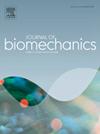Dynamic response of the aortic hemodynamic status to endovascular occlusion: A computational fluid dynamics study
IF 2.4
3区 医学
Q3 BIOPHYSICS
引用次数: 0
Abstract
The hemodynamic status following occlusion is crucial to the efficacy of resuscitative endovascular balloon occlusion of the aorta (REBOA), but existing information on this topic remains limited. This study clarifies the remodeling effects of REBOA on aortic hemodynamics. A geometric model of the aorta, derived from human imaging, is used to simulate various hemorrhagic scenarios (blood loss = 10 %, 25 %, 35 %, and 40 %) through reductions in cardiac output and increases in heart rate. Fluid-structure interaction simulations are performed to explore the relationship between blood pressure, cerebral perfusion, arterial deformation, and blood loss following thoracic aortic occlusion. The results indicated that, when the cerebral blood flow tolerance is reduced by 50 %, the recommended blood loss range for REBOA use is approximately 23.9–30.8 %, corresponding to an initial blood pressure range of 53–71 mmHg. Blood loss < 16.8 % (>90 mmHg) does not necessitate occlusion, whereas blood loss between 16.8 % and 23.9 % (71–90 mmHg) may lead to supraphysiological blood pressure and excessive arterial wall deformation. Blood loss > 30.8 % (<53 mmHg) impedes the achievement of reasonable pressure levels. These findings suggest that REBOA is effective only within a specific range of blood loss. Exceeding or falling below these thresholds can lead to adverse effects, such as hypertension or hemodynamic instability. These findings hold significant clinical relevance for emergency care.
求助全文
约1分钟内获得全文
求助全文
来源期刊

Journal of biomechanics
生物-工程:生物医学
CiteScore
5.10
自引率
4.20%
发文量
345
审稿时长
1 months
期刊介绍:
The Journal of Biomechanics publishes reports of original and substantial findings using the principles of mechanics to explore biological problems. Analytical, as well as experimental papers may be submitted, and the journal accepts original articles, surveys and perspective articles (usually by Editorial invitation only), book reviews and letters to the Editor. The criteria for acceptance of manuscripts include excellence, novelty, significance, clarity, conciseness and interest to the readership.
Papers published in the journal may cover a wide range of topics in biomechanics, including, but not limited to:
-Fundamental Topics - Biomechanics of the musculoskeletal, cardiovascular, and respiratory systems, mechanics of hard and soft tissues, biofluid mechanics, mechanics of prostheses and implant-tissue interfaces, mechanics of cells.
-Cardiovascular and Respiratory Biomechanics - Mechanics of blood-flow, air-flow, mechanics of the soft tissues, flow-tissue or flow-prosthesis interactions.
-Cell Biomechanics - Biomechanic analyses of cells, membranes and sub-cellular structures; the relationship of the mechanical environment to cell and tissue response.
-Dental Biomechanics - Design and analysis of dental tissues and prostheses, mechanics of chewing.
-Functional Tissue Engineering - The role of biomechanical factors in engineered tissue replacements and regenerative medicine.
-Injury Biomechanics - Mechanics of impact and trauma, dynamics of man-machine interaction.
-Molecular Biomechanics - Mechanical analyses of biomolecules.
-Orthopedic Biomechanics - Mechanics of fracture and fracture fixation, mechanics of implants and implant fixation, mechanics of bones and joints, wear of natural and artificial joints.
-Rehabilitation Biomechanics - Analyses of gait, mechanics of prosthetics and orthotics.
-Sports Biomechanics - Mechanical analyses of sports performance.
 求助内容:
求助内容: 应助结果提醒方式:
应助结果提醒方式:


